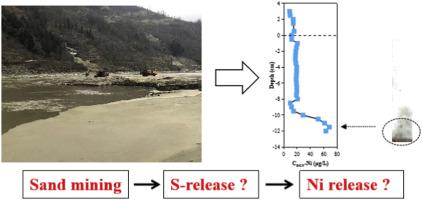当前位置:
X-MOL 学术
›
Appl. Geochem.
›
论文详情
Our official English website, www.x-mol.net, welcomes your
feedback! (Note: you will need to create a separate account there.)
Evaluation of the environment risk, fractions and mobilization of nickel (Ni) in sediments of the Jialing River by sediment quality guidelines, sequential extraction and Chelex-AgI gel DGT probe
Applied Geochemistry ( IF 3.1 ) Pub Date : 2020-07-01 , DOI: 10.1016/j.apgeochem.2020.104634 Tuo Zhang , Lijuan Li , Fei Xu , Xiangyu Chen , Li Du , Xinjian Wang , Yunxiang Li
Applied Geochemistry ( IF 3.1 ) Pub Date : 2020-07-01 , DOI: 10.1016/j.apgeochem.2020.104634 Tuo Zhang , Lijuan Li , Fei Xu , Xiangyu Chen , Li Du , Xinjian Wang , Yunxiang Li

|
Abstract The Jialing River is one of the largest tributaries of the Yangtze River and has the largest drainage area. Nickel (Ni) is a one of the most serious heavy metal contaminants in the downstream section of the Jialing River as a result of the prosperity of nearby chemical, electronic and mining industries. In the present work, sediment quality guidelines (SQGs), a Community Bureau of Reference (BCR) sequential extraction and the diffusive gradients in thin films (DGT) technique were applied to evaluate the environment risk, fractions and remobilization of Ni in the downstream Jialing River. The results indicated that the average total concentration of Ni (54.7 mg kg−1) at all sites was higher than the background values of soil in China and Sichuan (26.9 and 35.8 mg kg−1, respectively). Environment risk assessment with four types of SQG values found that at three sites, the Ni concentration was over two high guideline values (probable effect concentration, PEC; effect range median, ERM), indicating that Ni may frequently pose a threat to the local aquatic ecosystem. The DGT results showed that CDGT-Ni had an inverse variation trend with CDGT-Fe and presented a significant increasing trend at the bottom of the DGT probes. Flux results revealed that sediments at S1, S2 and S3 were the source for Ni release across the sediment-water interface (SWI), and only S4 was a sink for Ni. Two further studies found that CDGT-Ni presented a significant negative correlation with CDGT-Fe. In addition, the “hotspot” of CDGT-Ni at the bottom correlated well with the “dark area” of CDGT-S. These results indicated that Fe and S were factors that mitigated the release of Ni in the sediments.
更新日期:2020-07-01











































 京公网安备 11010802027423号
京公网安备 11010802027423号